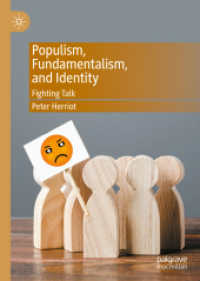- ホーム
- > 洋書
- > 英文書
- > Cinema / Film
Full Description
Since the late 1990s a new language has emerged in film scholarship and criticism in response to the popularity of American directors such as Wes Anderson, Charlie Kaufman, and David O. Russell. Increasingly, adjectives like 'quirky', 'cute', and 'smart' are used to describe these American films, with a focus on their ironic (and sometimes deliberately comical) stories, character situations and tones. Kim Wilkins argues that, beyond the seemingly superficial descriptions, 'American eccentric cinema' presents a formal and thematic eccentricity that is distinct to the American context. She distinguishes these films from mainstream Hollywood cinema as they exhibit irregularities in characterization, tone, and setting, and deviate from established generic conventions. Each chapter builds a case for this position through detailed film analyses and comparisons to earlier American traditions, such as the New Hollywood cinema of the 1960s and 1970s. American Eccentric Cinema promises to challenge the notion of irony in American contemporary cinema, and questions the relationship of irony to a complex national and individual identity.
Contents
Acknowledgements
Introduction
Neoliberal Citizenship and the Eccentric
Locating the Eccentric in Cinema
New Hollywood and Eccentric Connections
Chapter One: Defining American Eccentricity
Indie and Eccentricity
American Eccentricity and Irony
Anxiety
Eccentricity
Chapter Two: Road Films and National Identity
American Eccentricity and Genre
The Eccentric Road Film: From Easy Rider to The Darjeeling Limited
The Road and Kaufman's Mind Trips
Chapter Three: Overtly Cinematic Characterization
Overtly Cinematic Characters and Audience Identification
Wes Anderson and Overtly Cinematic Characterization
Eccentric or 'Smart' Characterization?
Wes Anderson's Eccentric Characters
Chapter Four: Hyper-Dialogue and the Eccentric Manner
The Shift from New Hollywood Naturalism to Eccentric Hyper-Dialogue
Dialogue and Convention
Hyper-Dialogue and Performance
Hyper-Dialogue as Dramatic Function
Hyper-Dialogue and Sincerity
Chapter Five: Eccentric Worlds
Eccentric Deviations from Realism
Eccentricity and the Intertextual World
Eccentric Cities: Magnolia
Conclusion: Beyond Eccentricity
Ripples of Eccentricity
Outside the Box
Index
Filmography
Bibliography








